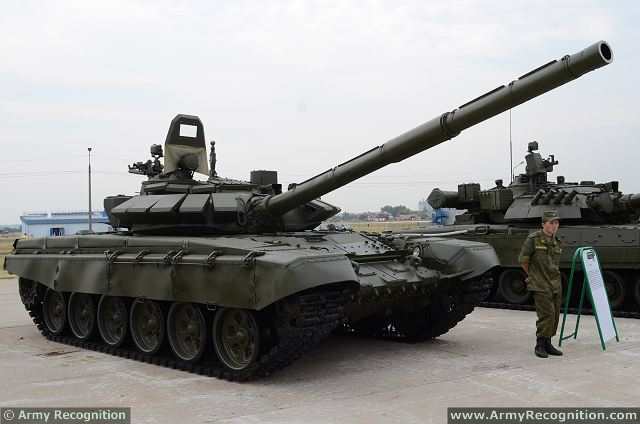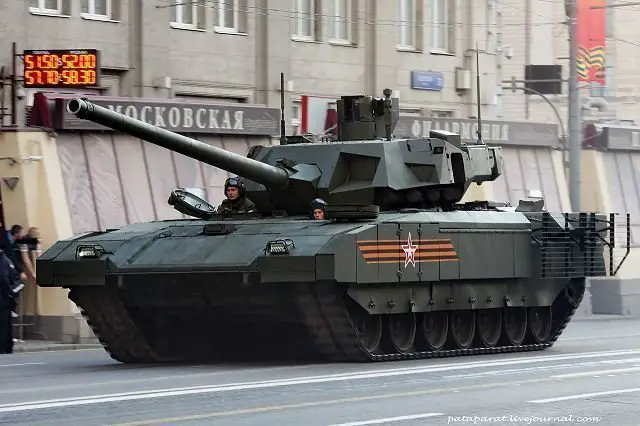Breaking news
Russia to equip MBT T-72 and T-90 with T-14 Armata's fire control system components 73012162.
| 2016
|
|
|||
|
Defence & Security News - Russia
|
|||
|
|
|||
| Russia to equip MBT T-72 and T-90 with T-14 Armata's fire control system components | |||
|
Russian main battle tanks T-72 and T-90 will be equipped with sophisticated components of the fire control system used by the T-14 tank based on the Armata chassis, e.g. the autotracker and computing unit, according to the Izvestia daily newspaper.
|
|||
|
|
|||
|
|
|||
|
The autotracker enables the gunner to simply aim the main armament at an enemy tank and press a special button, after which it will independently track the target, traversing the turret and raising or lowering the main armament accordingly. The computing unit, designed to analyze parameters from the tank’s speed and direction to weather conditions and the state of the main gun’s tube, calculates the optimal firing solution to destroy the target with a single shot.
At present, the Russian Defense Ministry has several versions of a large-scale upgrade of its T-72 and T-90 tank fleets. The advanced components earmarked for the introduction into them include the autotracker and computing unit of the fire control system of the T-14 Armata tank, a Defense Ministry official close to the subject told the Izvestia daily. After the Armata tank and its electronics are tested, the autotracker and computing unit are to be fitted to the elder versions of the T-72 and T-90, and their upgraded versions are slated for trials inside two to three years. According to the source, the installation of the sophisticated components is made easier by the Kalina fire control system equipping the three types of tanks, even though the Kalina is represented by three different generations. The Armata mounts the latest Kalina version. The T-72B3 and T-90 have a previous-generation iteration. In particular, the T-72B3 has an autotracker that is not as good as the one equipping the Armata, while the T-90 lacks even that, the Defense Ministry official explained. However, the technology and solutions of all of the above fire control systems are identical to a large degree. Hence, fitting the T-72 and T-90 with the Armata’s units is no big deal. The only problem is to adapt the software used by the autotracker to keep an eye on the target and by the computing unit to calculate allowances based on the data received. Many test firings on the move and at the halt have to be conducted for this purpose. The results produced in the tests will allow the software to be modified as required. |
|||
|
|
|||
 T-72B3 Main Battle Tank T-72B3 Main Battle Tank |
|||
|
|
|||
|
According to expert Alexei Khlopotov, the autotracker and computing unit increase the tank’s effectiveness in combat by several times, especially when they are combined with a multichannel sight.
"The main strength of such systems is the complete exclusion of man out of loop in aiming, which is especially important in stressful combat environment," Khlopotov says. "Every shot becomes absolutely accurate and far quicker compared with manual laying. He gunner only needs to select a target and then the autotracker and computing unit take over and do the rest in mere seconds. Then you select another enemy tank and repeat the procedure." The autotracker was pioneered by Japanese tank Type 90 in 1990 and then was introduced into the Israeli-made Merkava Mk.3B Baz and its derivatives. There also is an autotracker in South Korean tank K-2 Black Panther. Interestingly, the autotracker has not made it to NATO’s tanks en masse due to the high cost and sophistication of integrating its advanced components with the in-service fire control systems. As of now, provision has been made only for using such devices in the future M1A3 Abrams and Leopard 2 MBT Revolution, while it does not equip the in-service types, according to the Izvestia daily. |
|||
|
|
|||
|
© Copyright 2016 TASS. All rights reserved. This material may not be published, broadcast, rewritten or redistributed.
|
|||



























